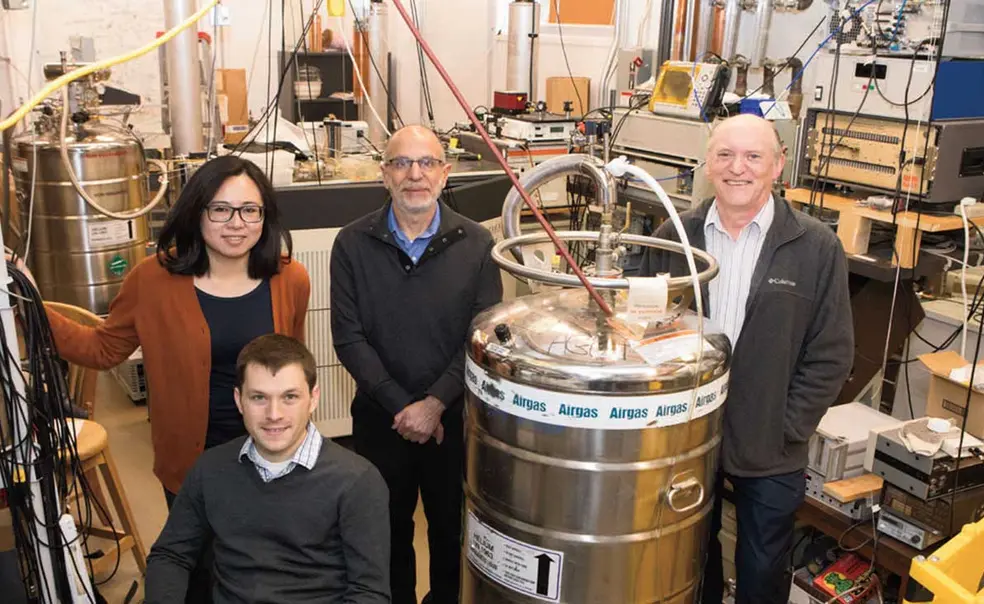A New Phase for Quantum Science at Princeton
In 1935, Albert Einstein, Boris Podolsky, and Nathan Rosen published one of the most famous papers in the history of physics. All three were appointed at the Institute for Advanced Study, temporarily housed in what is now Jones Hall on the University campus.
The paper discussed what Einstein would later deride as “spukhafte Fernwirkung” or “spooky action at a distance.” Quantum mechanics, the authors argued, entailed the bizarre idea that observation of a particle in, say, Princeton could simultaneously affect the state of another particle in, say, Oxford—or, for that matter, out by some distant star.
Podolsky annoyed Einstein by leaking the paper to The New York Times, which covered it under the headline “Einstein Attacks Quantum Theory.” Podolsky told the Times that although quantum mechanics made plenty of correct predictions, its consequences were too strange to provide a complete description of the physical world.
Everything in that bold and controversial 1935 paper has proven correct—except for the criticism of quantum mechanics. What Einstein called “spooky action at a distance,” and what scientists now call “quantum entanglement,” is a feature of the physical world—one with increasingly important practical applications.
Over the last century, quantum mechanics has provided the indispensable scientific foundation for a vast array of modern technologies, including semiconductors, lasers, computers, and nuclear power, to name only a few.
Now, the world stands on the cusp of what some are describing as a “second quantum revolution.” Scientists and engineers are developing theories and techniques to manipulate and control the most mind-boggling properties of quantum mechanics, such as entanglement and “superposition,” which permits a physical system to exist in a combination of two states simultaneously.
Potential applications include quantum computing, which makes use of both entanglement and superposition. An ordinary computer consists of bits that encode either a 0 or a 1. A quantum computer, by contrast, uses entangled quantum bits, or “qubits,” that contain superpositions of a 0 state and a 1 state. By harnessing these bizarre phenomena, quantum computers could eventually perform in seconds some tasks that would take classical computers years to complete.
Remarkably, at the same time that it pushes forward new and potentially transformative technologies, quantum science is also generating fresh insight into fundamental questions about the nature of the universe. For example, quantum theorists are discovering surprising connections with fields such as gravitation, topology, and computational algorithms.
Princeton is poised to lead the way in this exciting field. Indeed, in the years since Einstein, Podolsky, and Rosen published their paper, Princeton University has remained one of the world’s leading centers for the study of quantum science. For example, Princeton faculty members Philip Anderson (1977), Daniel Tsui (1998), and Duncan Haldane (2016) all won Nobel Prizes in physics for major contributions to the field.
Today, the Princeton Quantum Initiative (which you can read more about at quantum.princeton.edu) encompasses more than thirty faculty members across the physical sciences and engineering.
Princeton plays a major leadership role in the multi-institution Co-Design Center for Quantum Advantage, one of five new centers selected for creation pursuant to the National Quantum Initiative Act of 2018. The University is also home to the Princeton Center for Complex Materials, one of the nation’s select few NSF Materials Research Science and Engineering Centers.
Given its spectacular possibilities for both basic research and applied science, quantum science will undoubtedly be a focus of many leading research universities over the coming decades. Princeton’s approach is distinctive by its interdisciplinary breadth.
Quantum scientists are developing multiple techniques or “platforms” for harnessing effects such as entanglement and superposition. Most universities are concentrating on a particular platform; Princeton has scientists and engineers working on several of them.
Princeton also has brilliant scholars working on related challenges that must be overcome to realize the full potential of the second quantum revolution. These include chemists who are fabricating novel materials that can serve as platforms for qubits, and computer scientists who study the design of quantum algorithms and quantum compilers.
Princeton’s small size, collegial community, and cohesive structure enable scientists and engineers to work together across these different topics, drawing insight and inspiration from one another as they tackle related problems in different contexts.
The Princeton Plasma Physics Laboratory, which the University manages for the Department of Energy, provides two additional advantages: the capacity to host experiments of a scale beyond what is practical on the campus, and the possibility of using plasma to fabricate quantum devices and processors.
We expect to double down on our already formidable strengths in the years ahead. These new investments will extend a spectacular Princeton tradition of excellence, creativity, and innovation into an exciting future.
Princeton University has been entangled with the strange and beautiful world of quantum mechanics since even before Einstein wandered our campus. The history of that science at this University has been extraordinary, and the phases to come will undoubtedly be equally fascinating and marvelous to observe.











No responses yet